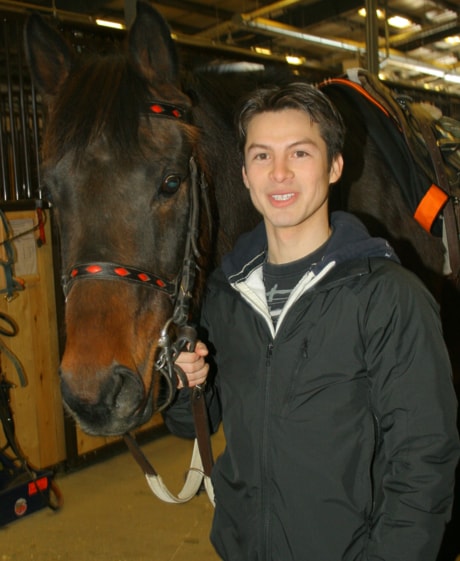OLDS COLLEGE — The horse does 90 per cent of the work, says a young jockey being touted as the Wayne Gretzky of horse racing.
Omar Moreno, 25, returned to Olds College on Tuesday for a reunion with the people who set him on the path to horse racing stardom, including the Eclipse award for the most successful apprentice jockey in North America and the Sovereign award for the best in Canada, both for 2010.
Now a fully-qualified jockey, Moreno’s horses have earned $5.8 million in his short career and he’s on line for a second Sovereign award, says Dennis Ejack, the Red Deer-based bloodstock agent who first pushed Moreno into horse racing.
Jockeys get 10 per cent of the purse, with a minimum of $100 to $150 per ride.
Rescued from the war in El Salvador and brought to Canada when he was six, Moreno had been living with a foster family in Edmonton. The house was only two blocks from the Edmonton Northlands racetrack, but that meant nothing to Moreno at the time.
Ejack first met him in the boxing ring while he was still a teenager.
“I coached Omar in boxing — that’s my hobby,” said Ejack.
Over the next few years, Moreno would win three national titles in his weight division.
But there is not much of a future in amateur boxing and Moreno was struggling with a shoulder injury.
As a young adult, he had started house painting to earn a living.
Ejack thought Moreno could do better than that. Assessing the young man’s small stature, athletic ability and enormous work ethic, Ejack hit on a plan.
Moreno had never touched a racehorse and didn’t even know what a jockey was in the fall of 2006 when Ejack brought him to Olds to have a look at the 15-week race rider program offered at Olds College.
Moreno said on Tuesday that he was nervous at the time, but wasn’t keen on spending the rest of his life painting houses, so decided to give it a try.
But just getting by wasn’t an option.
“I hate being second best at things. I’m a competitive person. I’m a sore loser.”
Before he could even start, he had to take riding lessons to pass the entry requirements.
Moreno earned his diploma the next year and started out in Alberta, riding races in Grande Prairie, Lethbridge and Edmonton before moving on to Woodbine at Toronto, where he is now based.
Last year alone, Moreno rode about 1,100 horses and people are banging on his agent’s door, asking him to ride their horses.
That’s outstanding performance for any jockey, never mind one with no background in the industry, said Shirley McClellan, chair of Horse Racing Alberta, a member of the Olds College Board of Governors and the person for whom the college named its new riding arena.
“(Moreno’s success) means a lot for the program because he’s an inspiration for the students. He’s a hero for them, and everybody needs a hero,” said McClellan.
“You know, he started so raw (but) he worked hard. Everybody talks about his work ethic, and I think because of his work ethic, he got more and more opportunities.”
Jim Haggan, manager of programs for Horse Racing Alberta, said the racing programs at Olds College are part of a scheme to improve the industry in Alberta. The groom program was first, followed about six years ago with the race rider program. Another program for barn managers is now being developed, said Haggan.
The goal is to create something similar to the four-year degree program being offered at the University of Arizona in Tucson, where training is available in all aspects of the industry, he said.
So far, the Alberta programs are filling a huge gap in the number of people available not just to ride the races, but to help exercise the horses between races, said Haggan.
“On any given day, we have anywhere between 15 and 20 exercise riders that graduated from this program,” said Haggan.
“On average, they ride 10 horses a day, so that’s 200 a day being galloped. If we didn’t have those kids, we wouldn’t be able to get those horses out there.”
Right now, there are nine students enrolled in the program, which has a capacity for 15, said Mara-Coote Freeman, who recently retired as head of the animals sciences department within the college’s continuing education program.
Moreno said he feels lucky to have had encouragement and support in a career that, five years ago, he didn’t know existed.
He’s had some memorable rides so far and looks forward to constantly improving his performance on the track, knowing that his job is to get the best performance possible from the horse he is riding.
“A bad rider will put a horse in a bad spot, then the horse is going to get shut out and have nowhere to go. Great riders have told me the best way to ride a horse is just to be a good passenger. A good jockey gives a good horse a fighting chance.”
bkossowan@www.reddeeradvocate.com
